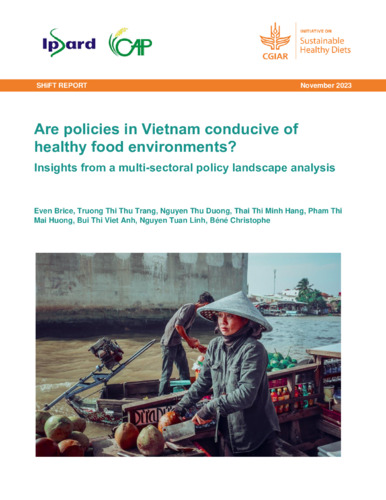Are policies in Vietnam conducive of healthy food environments? Insights from a multi-sectoral policy landscape analysis
Current food systems fail to address the triple burden of malnutrition — undernutrition, micronutrient deficiencies, and overnutrition (Popkin, 2019; Béné, 2019; Fanzo, 2020). The Food and Agriculture Organization (FAO) reports that approximately 462 million people worldwide are underweight, while 1.9 billion adults (39%) are overweight or obese. In 2020, globally, 149 million children under the age of five were stunted, 45 million were wasted, and 38.9 million were overweight or obese (FAO, 2021).
Many populations have shifted from traditional diets which tend to be locally specific and include coarse grains, pulses, fruits, vegetables, and some meat or fish depending on the season, towards a standardized global diet that is high in animal source proteins, fat, sugar, and processed packaged foods. This dietary shift has occurred over different time scales and in different regions and is also happening in Vietnam (NIN, 2021).
In Vietnam, the prevalence of undernourishment decreased from 18% to 11% between 2008 and 2018 (FAO, 2018). Improvements have also been observed in the chronic malnutrition (stunting) of children under the age of five, which has decreased from 32% to 24% between 2007 and 2015 (UNICEF and WHO, 2019). However, the rate of overweight and obesity has been rapidly increasing, especially in urban populations (Viet Nam Ministry of Health, 2021). The World Health Organization (WHO) reported in 2018 that 9.7% of children and adolescents in Vietnam were overweight, as well as 25% of women and 20% of men (WHO, 2018). More recent figures show that the prevalence of overweight and obesity among school-aged children increased from 8.5% in 2010 to 19% in 2020, with urban areas showing a rate of 26.8%, rural areas at 18.3%, and mountainous regions at 6.9% (NIN, 2021). Overweight and obese individuals suffer from increased risk of non-communicable diseases (NCDs), such as type 2 diabetes, cardiovascular diseases, and some types of cancer. Unhealthy eating is largely the result of unhealthy food environments (Hawkes, 2006; HLPE, 2017). Therefore, better knowledge and understanding of food environments is needed to develop interventions that lead to healthy food systems.

